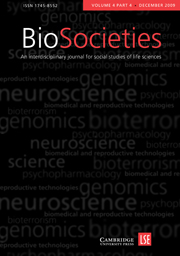Article contents
Who's Credible? Expressions of Consensus and Conflict in Focus Groups about DNA Patenting
Published online by Cambridge University Press: 01 March 2009
Abstract
In this article I explore attributions of credibility, important to designations of ‘expertise’, within the area of DNA patenting. I define ‘credibility’ as a relationship of recognition people establish to other actors. Through repeated interviews, interspersed with the provision of information, I have identified two different ways in which respondents position themselves in relation other actors as a way of assessing their credibility: when assuming a ‘partisan position’, they explicitly draw on ideological convictions; when assuming a ‘hierarchical position’, the ranking of credibility depends on how informed and objective others are perceived to be. The positions embody different roles for the respondents as ‘citizens’ and as ‘lay persons’, respectively; that is, they indicate the possession of contrasting ideas about their own relevance in policy matters. This raises the question of how to interpret the fact that people disqualify themselves from policy making, seeing themselves as incompetent. Challenging current conflict-focused models in the public understanding of science (PUS) literature, I argue that the hierarchical position can be interpreted as a broader desire for consensus. In the patent area, I show that paying attention to the hierarchical position is crucial to understanding why an industry representative is regarded by some to be a credible ‘expert’. The study sheds light on the ‘public understanding of expertise’ more broadly, and within the bioeconomic field in particular.
Keywords
- Type
- Articles
- Information
- Copyright
- Copyright © London School of Economics and Political Science 2009
References
- 2
- Cited by


